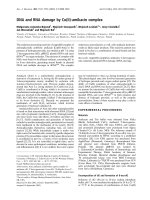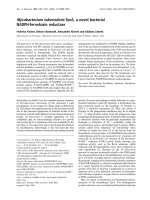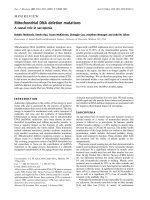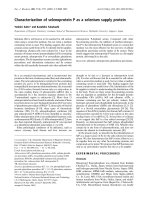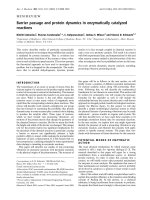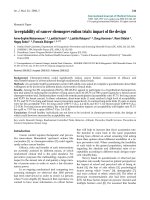Báo cáo y học: "Rheumatologists, take heart! We may be doing something right" docx
Bạn đang xem bản rút gọn của tài liệu. Xem và tải ngay bản đầy đủ của tài liệu tại đây (38.58 KB, 2 trang )
Page 1 of 2
(page number not for citation purposes)
Available online />Abstract
In the present issue of Arthritis Research & Therapy data are
presented suggesting that antirheumatic therapies decrease the
risk of cardiovascular disease in patients with rheumatoid arthritis.
The QUEST-RA group, a large international collaboration, analyzed
data on 4,363 patients in a cross-sectional manner. Traditional risk
factors were all significantly associated with cardiovascular events,
and the presence of extraarticular disease significantly increased
the risk, confirming a previous publication. The most interesting
analysis in this study suggests that effective antirheumatic treat-
ment, with traditional disease-modifying antirheumatic drugs
(DMARDs), glucocorticoids, or anti-TNF biologics, reduces the risk
of cardiovascular disease in rheumatoid arthritis. Some methodo-
logical issues are discussed, however, and confirmatory studies
are suggested.
Patients with rheumatoid arthritis (RA) are at increased risk
for cardiovascular disease. It is not yet known if antirheumatic
treatments can modulate this risk in a favorable manner.
In the present issue of Arthritis Research & Therapy Naranjo
and colleagues present data suggesting antirheumatic treat-
ments do modulate this increased risk [1]. The authors
present on behalf of the QUEST-RA group, a large
international collaboration involving 48 rheumatologists in 15
countries. Data were collected on 4,363 patients with RA in a
cross-sectional manner, from patients and physicians by
recall and chart review. From this large dataset, the authors
were able to determine a number of facts. The patient
population was quite typical for established RA, and 9.3% of
these patients reported having had cardiovascular disease or
events (heart attack and angina, coronary heart disease,
coronary by-pass surgery, and stroke were included, but only
if they occurred after RA had developed). The presence of
traditional risk factors was ascertained and, by comparing
patients with and without a cardiovascular event, most of
these risk factors could be confirmed: higher age, male sex,
hypertension, smoking (ever), diabetes, and hyperlipidemia
were all significantly associated with the risk for
cardiovascular events. A more interesting finding was that the
presence of extraarticular disease clearly increased the risk of
cardiovascular events, confirming a previous publication by
Turesson and colleagues [2].
The real importance of this study, however, may lie in the
final analysis, presented in Table 5 of their paper, which
intends to determine to what extent antirheumatic treatment
modulates the risk of cardiovascular disease [1]. To achieve
this, the authors collected data from the physicians on the
treatments (glucocorticoids, conventional disease-modifying
antirheumatic drugs [DMARDs], and biologics) given to the
patients with start and stop dates. They then used the
duration of treatment for each drug in each patient
separately as an independent variable in a multivariate
analysis where potential confounders were also included,
including age and sex, other traditional risk factors, and
disease activity by the Disease Activity Score as well as the
Health Assessment Questionnaire disability index. These
analyses all show a negative relationship between the length
of treatment with conventional DMARDs and the risk of
cardiovascular events; that is, longer duration of treatment
with, say, methotrexate was associated with a somewhat
lesser risk than a shorter duration of treatment with the same
agent. The risk reduction was quantitatively strongest with
leflunomide, and was statistically significant in the most
stringent analysis for all but two of the drugs under study. A
significant but weaker relationship was also found, rather
surprisingly, with glucocorticoids, and, more in line with
current expectations, a stronger relationship with anti-TNF
biologics (other biologics were not assessed). The authors
cautiously interpret these data as suggesting that effective
antirheumatic treatment reduces the risk of cardiovascular
disease in patients with RA.
Editorial
Rheumatologists, take heart! We may be doing something right
Ronald F van Vollenhoven
Rheumatology Unit, the Karolinska Institute, Department of Rheumatology, The Karolinska University Hospital, Reumatologen D2-1, 17176 Stockholm,
Sweden
Corresponding author: Ronald F van Vollenhoven,
Published: 7 March 2008 Arthritis Research & Therapy 2008, 10:105 (doi:10.1186/ar2364)
This article is online at />© 2008 BioMed Central Ltd
See related research by Naranjo et al., />DMARDs = disease-modifying antirheumatic drugs; RA = rheumatoid arthritis; TNF = tumor necrosis factor.
Page 2 of 2
(page number not for citation purposes)
Arthritis Research & Therapy Vol 10 No 2 van Vollenhoven
This may well be true. The current study design – a
retrospective cross-sectional review based in some part on
patient recall – and using internal comparisons rather than a
control group, however, are not ideal to address this issue. In
particular, the use of length of treatment as the variable of
interest raises both conceptual and technical issues. The
conceptual question is whether the length of time that a
patient stays on a treatment is a good indication that the
patient had good disease control during that time. Obviously
this is not necessarily true at the individual level, but at the
group level this approach may work reasonably well – as
demonstrated in a number of studies, including studies of
survival on drugs [3,4] and a study of radiological progression
in the first 2 years of disease [5].
The technical issues are more formidable. First of all, and as the
authors themselves admit, the study is subject to left-
censoring: those patients who died of a cardiovascular event
could obviously not contribute data. One interpretation of the
study is therefore that antirheumatic therapy does not change
the risk of a cardiovascular event, but increases the risk that the
event will prove fatal! Obviously this is a cynical interpretation if
there ever was one, but it may serve to underscore the
difficulties with retrospective studies. Another problem is that
the length of each treatment is restricted by the duration of the
disease itself: those patients with the shortest disease duration
at inclusion would also be more likely to contribute shorter
treatment courses than those with the longer disease duration.
But, importantly, this particular problem would make the results
go the other way, so that the criticism in fact strengthens the
conclusions. A final concern worth mentioning is a channeling
bias: it is conceivable that patients were given antirheumatic
therapies based in part on the perception of risks associated
with these agents for that particular patient, and cardiovascular
risk factors might have played in that decision. An example
would be that leflunomide would be chosen less often for
patients with hypertension, or that glucocorticoids would be
avoided in patients with diabetes. When the authors controlled
for these known risk factors, however, the association between
treatment and risk was generally maintained.
Taking these data at face value, it is quite striking that almost
all of the antirheumatic therapies investigated provided a
benefit. This would strongly argue against a specific
pharmacologic effect separate from the antirheumatic effect,
but rather supports the idea that this efficacy is conveyed by
decreasing the immune-mediated inflammatory process
underlying atherogenesis [6] and/or plaque instability [7].
The final message of Naranjo and colleagues’ paper, and one
that should be encouraging to those of us managing patients,
is that our insistence on the sustained use of appropriate
antirheumatic therapies, while not always the most popular
with patients, has been the right approach all along – not only
with a view on the rheumatic disease itself, but also for the
cardiovascular complications.
In summary, the possibility that antirheumatic therapy
decreases the risk for cardiovascular complications is
tantalizing. The current study, while not exactly proving this
point, adds a further measure of support to the concept, and
suggests that it must now be formally addressed, either by a
rigorously designed and implemented prospective cohort
approach or by a controlled clinical trial.
Competing interests
The author declares that they have no competing interests.
References
1. Naranjo A, Sokka T, Descalzo MA, Calvo-Alen J, Horslev-Petersen
K, Luukkainen R, Combe B, Burmester GR, Devlin J, Ferraccioli G,
Morelli A, Hoekstra M, Majdan M, Sadkiewicz S, Belmonte M,
Holmqvist AC, Choy E, Tunc R, Dimic A, Bergman MJ, Toloza S,
Pincus T: Cardiovascular disease in patients with rheumatoid
arthritis. Results from the QUEST-RA study. Arthritis Res Ther
2008, 10:R30.
2. Turesson C, McClelland RL, Christianson TJ, Matteson EL:
Severe extra-articular disease manifestations are associated
with an increased risk of first ever cardiovascular events in
patients with rheumatoid arthritis. Ann Rheum Dis 2007, 66:
70-75.
3. Wijnands MJ, van’t Hof MA, van Leeuwen MA, van Rijswijk MH,
van de Putte LB, van Riel PL: Long-term second-line treatment:
a prospective drug survival study. Br J Rheumatol 1992, 31:
253-258.
4. Wolfe F: The epidemiology of drug treatment failure in
rheumatoid arthritis. Baillieres Clin Rheumatol 1995, 9:619-
632.
5. Wick MC, Lindblad S, Weiss RJ, Klareskog L, van Vollenhoven
RF: Estimated prediagnosis radiological progression: an
important tool for studying the effects of early disease modi-
fying antirheumatic drug treatment in rheumatoid arthritis.
Ann Rheum Dis 2005, 64:134-137.
6. Hansson GK, Robertson AK, Söderberg-Nauclér C: Inflamma-
tion and atherosclerosis. Annu Rev Pathol 2006, 1:297-329.
7. van der Wal AC, Becker AE: Atherosclerotic plaque rupture –
pathologic basis of plaque stability and instability. Cardiovasc
Res 1999, 41:334-344.
